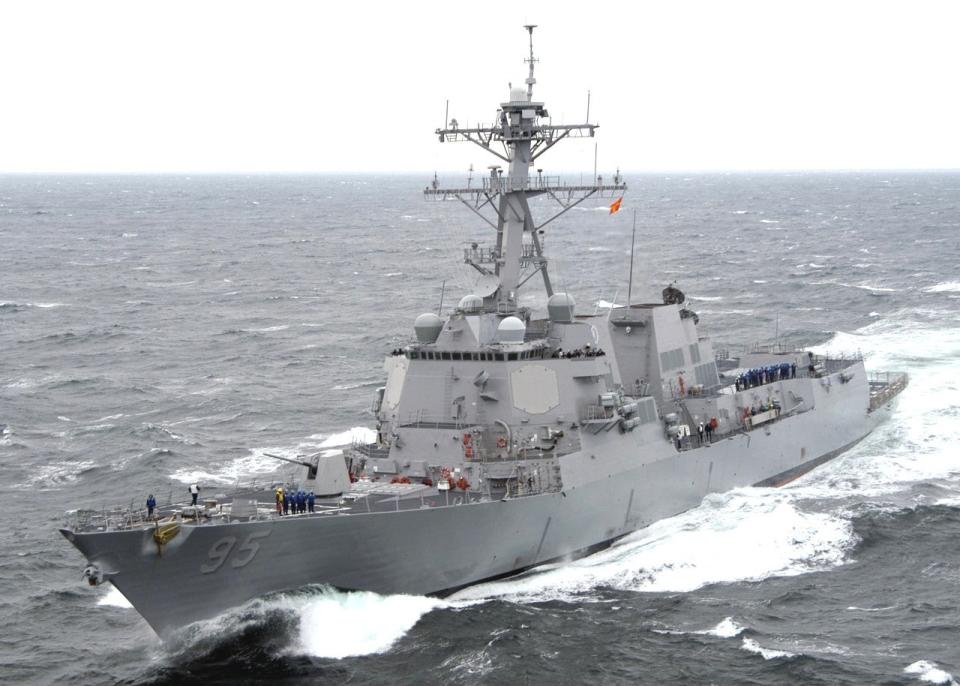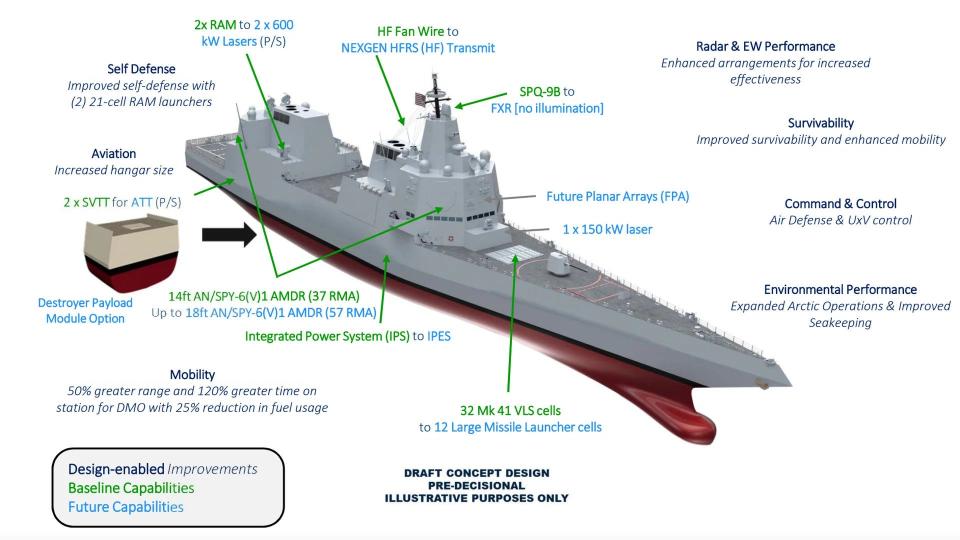Middle Aged Navy Destroyers Getting '2.0' Upgrade Package

The U.S. Navy has named the first four Arleigh Burke class destroyers that will receive a slate of major upgrades, including new radars and advanced electronic warfare suites. One of these ships, the USS Pinckney, has already gotten its new electronic warfare system, which has completely transformed its outward appearance. This is all part of the Navy's broader modernization plans for its destroyer fleets, which also includes a program to develop and acquire an entirely new design currently known as DDG(X).
U.S. Navy Capt. Tim Moore, who is in charge of what is currently known as the Destroyer Modernization 2.0 Program, provided new details about the upgrade effort at the Surface Navy Association's main annual symposium yesterday. USS James E. Williams (DDG-95), USS Chung Hoon (DDG-93), and USS Halsey (DDG-97), along with the Pinckney (DDG-91) are now set to be brought up what has also been called the DDG-51 Mod 2.0 or DDG 2.0 standard. DDG-51 is the hull number for the USS Arleigh Burke, the lead ship in this class.

Pinckney, James E. Williams, Chung Hoon, and Halsey are all Flight IIA subvariants of the Arleigh Burke, an improved version of the design that was developed in the late 1990s. Of the 73 Burkes in Navy service today, 34 are baseline Flight IIA types. Another 10 are Flight IIA Restart or Flight IIA Technology Insertion versions with additional improvements. Three more Flight IIA Technology Insertion Burkes, as well as several examples of the newer enlarged Flight III subclass, are currently in various stages of construction.

Capt. Moore outlined four key components of the Mod 2.0 upgrade package yesterday, according to Breaking Defense. These are the new AN/ALQ-32(V)7 Surface Electronic Warfare Improvement Program (SEWIP) Block III electronic warfare suite, and additional thermal management systems to help keep it cool, as well as the new AN/SPY-6(V)4 radar and an improved version of the Aegis Combat System.

As already noted, the USS Pinckney has the SEWIP Block III suite now. As can be seen at the top of this story and below, the integration of the system has radically changed how that ship appears with the addition of two huge fully enclosed extensions on either side of the main superstructure. These new geometric structures extend down the upper edge of the ship's hull and protrude significantly outward. The War Zone has explored the full scope and scale of those physical modifications in detail in the past.

Northrop Grumman's SEWIP Block III suite itself represents a revolutionary capability leap over previous iterations of the AN/SLQ-32 system. The new variant features active electronically scanned array (AESA) technology capable of putting out powerful and highly focused bursts of radio-frequency energy that can be used to launch electronic attacks on multiple targets along different vectors simultaneously. It also has advanced capabilities to detect, geolocate, and categorize threats passively. The system's arrays have the potential to also be used as radars and communications nodes. You can read more about the full extent of what the system can do in this past War Zone piece.
https://www.youtube.com/watch?v=H2HjzGZRGB8\u0026t=2s
Raytheon's AN/SPY-6(V)4 radar is a scaled-down derivative of the AN/SPY-6(V)1 Air and Missile Defense Radar (AMDR) that is a key component of the Flight III Arleigh Burke design. All AN/SPY-6 radars feature active electronically scanned arrays and are made up of groups of cube-shaped Radar Modular Assemblies (RMAs). The (V)1 version has four fixed arrays each with 37 RMAs. The (V)4 has four fixed arrays, as well, but with 24 RMAs apiece.

Even the smaller version of the AN/SPY-6 will be able to track more targets at greater ranges with greater precision and fidelity than the AN/SPY-1 passive electronically scanned array radars currently found on older Burkes. The Navy is also acquiring two other radars in the SPY-6 family for integration on other types of ships, and you can read more about them all in more detail here.
https://www.youtube.com/watch?v=YZZ3A05RdxE
Then there is the new Aegis Combat System baseline. Versions of Aegis have been in use on U.S. Navy warships for decades now and it is not immediately clear what new and improved functionalities the version that is part of the Mod 2.0 package will feature.
The Navy is already testing a new "virtualized" variation of Aegis on another Arleigh Burke class destroyer, the Flight IIA USS Winston S. Churchill (DDG-81). Virtulized Aegis helps reduce the hardware footprint of the system, which in turn makes it easier to integrate more capability and do so without greater physical bulk. You can read more about how this works, as well as Aegis in general, in this past War Zone feature.
https://www.youtube.com/watch?v=dMUfDCrxR2U
When exactly the Mod 2.0 work on the initial four Arleigh Burke destroyers will be completed is unclear. The Navy's Capt. Moore explained the current plan is to upgrade the initial four destroyers to the new configuration in two distinct phases, according to Breaking Defense. The warships will receive all of the components of the package in the first phase except for the new radar, which will be integrated afterward.
“I don’t want to publish that [schedule] here because we’re trying to bring that to the left as best we can,” Moore said, per Breaking Defense's report. Moore did add that once the first four Burkes are upgraded, then the Navy plans to begin upgrading other ships in that class to the Mod 2.0 configuration. The service has said in the past that it could upgrade as many as 20 Flight IIAs to this new standard.
The Navy is also still acquiring new Flight III Arleigh Burkes. The Flight III types are set to become the Navy's primary air defense command and control platform afloat, a role previously occupied by the service's Ticonderoga class cruisers, which are in the process of being retired.
The first Flight III Burke, the USS Jack H. Lucas (DDG-125), entered service last year. Future Flight III Burkes are expected to incorporate additional upgrades. Navy budget documents show plans to eventually integrate the SEWIP Block III electronic warfare suite onto at least three of these warships in the coming years.
https://www.youtube.com/watch?v=qTDt3UiOqL0
All of this is also leading up to the Navy's planned acquisition of a new and substantially larger class of destroyers, currently known as DDG(X). The service is still very much ironing out its requirements for this future warship, but it is expected to have a displacement of around 13,500 tons. By comparison, the Flight III Arleigh Burke notably has a displacement of just 9,700 tons. The Navy's three Zumwalt class stealth destroyers have displacements of around 15,000 tons. The DDG(X) looks set to be in the middle, size-wise, between these two designs.
Capability-wise, the Navy wants DDG(X) to feature the AN/SPY-6(V)1 radar, have an advanced propulsion system, and be heavily automated (which could translate to a smaller crew size). You can read more about what is known so far about the DDG(X) requirements here.

“Just from a design standpoint, our shipbuilding programs are evolutionary vice revolutionary,” Navy Rear Adm. Fred Pyle, the head of the Surface Warfare Division within the Office of the Chief of Naval Operations, told USNI News in an interview yesterday. “Where design and automation come in for DDG(X) is the hull form, what we’re doing in the propulsion plant, and those other enablers are the platform.”
"We want a plant that’s efficient, and less dependent on the logistics for us," Pyle added. "We’re looking at all options, as we look at propulsion."
The Navy currently hopes to begin buying DDG(X)s in the 2032 Fiscal Year. However, the service says it wants to procure these vessels in a way that does not upset other shipbuilding schedules, particularly with regard to future Arleigh Burkes.
A three-year overlap with ongoing Arleigh Burke construction is the current goal "to make sure we do no harm to our shipbuilding industry, whether it’s Bath Iron Works or [Huntington Ingalls Industries],” Rear Adm. Pyle told USNI News. Bath Iron Works and the Ingalls Shipbuilding division of Huntington Ingalls Industries are the two yards currently producing Arleigh Burke class destroyers.
https://www.youtube.com/watch?v=CQknH-rVAvU
This, of course, comes amid concerns that have been growing for years about available shipyard capacity in the United States to build warships, as well as submarines, of any kind. Yard space for major upgrades and routine maintenance has been a growing issue, as well.
Navy Vice Adm. Brendan McLane, the service's top surface warfare office, told reporters last week that the service typically has between 50 and 60 major surface warships available for operations on any given day, according to Breaking Defense. This is short of a current self-imposed goal of 75 ships available daily.
"The 75 ships counted do not include carriers, submarines, Military Sealift Command ships and classes that contain just a handful of vessels, such as the Zumwalt class destroyers and the expeditionary sea bases," Breaking Defense noted. Much of the lost operational time is due to maintenance backlogs.
“Since 2019, we’ve reduced our days of maintenance delay by 43 and a half percent,” Vice Adm. McLane said. “We’re going to have to keep our eye on this and continue to try harder.”
These issues are made even more worrisome given the exponentially larger size and scope of the shipbuilding industry in China. The U.S. military describes China's People's Liberation Army as the "pacing threat" that it primarily uses for future planning purposes across the board. There are also persistent fears that a conflict with the Chinese in the Pacific might erupt before the end of the decade. The Navy's surface and subsurface fleets would be critical in any such future fight.

All of this can only put more emphasis on the Navy's need for its various destroyer modernization efforts, and for them to stay on schedule. The service is now taking important steps forward with the Mod 2.0 upgrade program for a portion of its Arleigh Burke fleet, the size of which is still expanding, as well as the acquisition of the future DDG(X).
Contact the author: [email protected]
